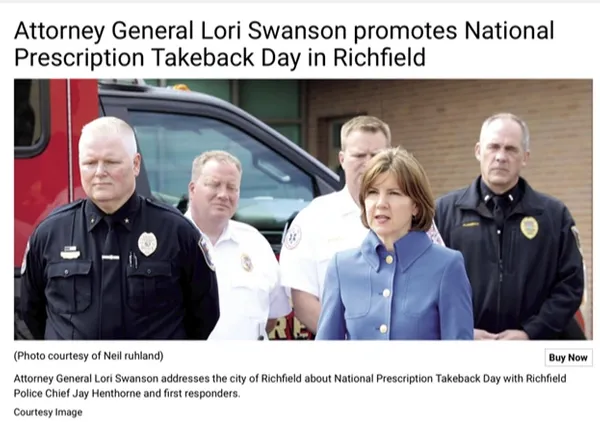at 612-315-3037 or
www.swansonhatch.com

In July of 2018, Lori Swanson filed suit against Purdue Pharma (“Purdue”), the manufacturer of the opioid Oxycontin. She was joined by other Attorneys General who filed similar lawsuits, including New York (August, 2018), Tennessee (July, 2018); Massachusetts (June, 2018); Colorado (September 2018), Florida (May of 2018), Nevada (May, 2018), North Carolina (May of 2018), Texas (May of 2018), and North Dakota (May, 2018).
OxyContin, introduced in 1995, was proclaimed by Purdue to be a long-acting pain killer with low abuse potential because, unlike immediate release oxycodone, Oxycontin had time-released properties that did not give the type of rush associated with immediately ingested pain killers. As it turns out, there was not a scientific basis upon which to make this claim.
Through the 1990s, Purdue aggressively marketed the drug to physicians. It paid physicians to go out and speak at seminars about the benefits of Oxycontin. During this heavy promotion, Purdue was aware that Oxycontin was abused, with reports that the pills were being crushed and snorted and stolen from pharmacies. The New York Timesstates that over 100 internal company memos between 1997 and 1999 included the words "street value," "crush," or "snort.”
At the start of 2000, widespread reports of OxyContin abuse surfaced. The results obtained from a proactive abuse surveillance program called Research Abused, Diversion, and Addiction-Related Surveillance (RADARS) found Oxycontin and hydrocodone the most commonly abused pain medications. In 2012, the New England Journal of Medicinepublished a study that found that "76 percent of those seeking help for heroin addiction began by abusing pharmaceutical narcotics, primarily OxyContin.”
In 2016, the Los Angeles Timespublished an investigative report that Purdue misrepresented the efficacy of OxyContin's 12-hour schedule. The newspaper claimed claimed that Oxycontin did not adequately control pain, resulting in withdrawal symptoms including intense craving for the drug at the end of a 12 hour period. The conclusion was that the craving at the end of a 12-hour dosage increased, rather than decreased, the addictive properties of the drug. Using Purdue documents and other records, the paper claimed that Purdue was aware of this problem before the drug went to market but "held fast to the claim of 12-hour relief.”
Due to the popularity of Oxycontin, Purdue increased its earnings from a few billion in 2007to $35 billion by 2017.
Swanson’s lawsuit sought to recoup money lost by Minnesota taxpayers as a result of the company’s conduct. Modeled after successful efforts to sue tobacco companies for the harm cigarettes caused, Swanson made it clear at the outset that she wanted and funds recovered from the lawsuit to fund addiction treatment.
Swanson accused the pharmaceutical company of promoting “fake research” which declared that OxyContin had a very low addiction rate. She also criticized Purdue for bankrolling self-serving seminars and for paying physicians to promote the message that Oxycontin was a miracle painkiller with a low addiction rate.
In addition, Swanson was highly critical of Purdue for falsely claiming that the drug worked for 12 hours. She also criticized Purdue for blaming patients rather than the drug itself for their addictions.
The lawsuit was pending at the end of Swanson’s term.
References: